Capital Market Instruments and Characteristics of Securities Market
VerifiedAdded on 2023/01/06
|11
|3728
|50
AI Summary
This document provides information about capital market instruments such as equities, debt instruments, and derivatives. It also discusses the characteristics of the securities market, including its organization and predictability. Additionally, it explains the primary market and its role in the initial offering of securities, as well as the secondary market where securities are bought and sold.
Contribute Materials
Your contribution can guide someone’s learning journey. Share your
documents today.
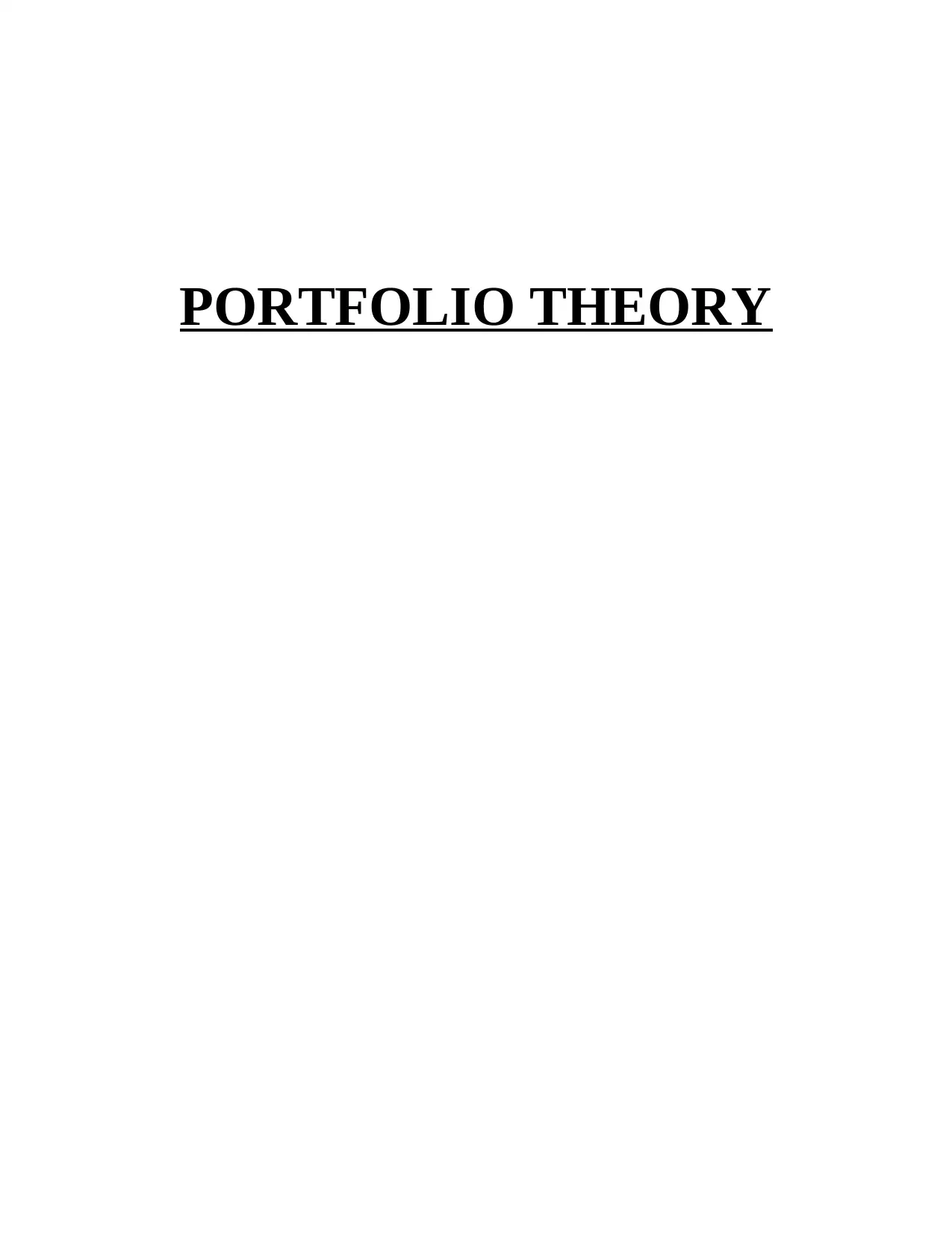
PORTFOLIO THEORY
Secure Best Marks with AI Grader
Need help grading? Try our AI Grader for instant feedback on your assignments.

QUESTION 1
A
i) Risk premium
Risk premium refers to investment return which the asset is expected to yield in the
excess of risk free return. Risk premium of the asset is form of the compensation for investors.
Risk premium represents payment to the investors to tolerate extra risk in the given investments
over the risk free asset. Investors are to be compensated for risk undertaken by them making the
investments. It comes in form of risk premium. Equity risk premium refers to premium which the
investors expects of making to take relatively high risk of buying the stocks.
It could be better understood as, high quality bonds of established corporations who are
earning large profits that typically face default risk (Platanakis and Urquhart, 2020). These bonds
therefore pay lower interest rate as compared with the bonds issued by companies that are less –
established with uncertain profitability and high default risk. These companies pay higher rate of
interest to the investors for higher degree of risk tolerance
Risk premium could be construes as the true earning reward as risky investments are
more profitable as they succeed. Paradigm shifting breakthrough are likely to come from the new
& risky initiatives. These type of investments offer potentially superior returns that business
owner uses for rewarding the investors.
Major sources of uncertainty
Certainty could be defined as lack of surety or certainty of event. In the accounting or
financial terms uncertainty means inability of telling in advance outcomes or consequences as
due to lack of bases or knowledge on which predictions are to be made. It is widely used in the
financial accounting as there are number of events which are beyond the control of company and
could greatly affect the transactions. It is harder to make the financial decisions at times of
uncertainty (Heaton, Polson, and Witte, 2016). There are several sources of uncertainty that
might affect the returns and risks.
The major sources of uncertainty are like political changes that leads organisations to
change different operations of the business. Economic uncertainty which have significant impact
over the returns like increase in inflation rate or change in interest rates, lowering economy.
Sudden change in the social factors impacting the organisation could lead the business to suffer
A
i) Risk premium
Risk premium refers to investment return which the asset is expected to yield in the
excess of risk free return. Risk premium of the asset is form of the compensation for investors.
Risk premium represents payment to the investors to tolerate extra risk in the given investments
over the risk free asset. Investors are to be compensated for risk undertaken by them making the
investments. It comes in form of risk premium. Equity risk premium refers to premium which the
investors expects of making to take relatively high risk of buying the stocks.
It could be better understood as, high quality bonds of established corporations who are
earning large profits that typically face default risk (Platanakis and Urquhart, 2020). These bonds
therefore pay lower interest rate as compared with the bonds issued by companies that are less –
established with uncertain profitability and high default risk. These companies pay higher rate of
interest to the investors for higher degree of risk tolerance
Risk premium could be construes as the true earning reward as risky investments are
more profitable as they succeed. Paradigm shifting breakthrough are likely to come from the new
& risky initiatives. These type of investments offer potentially superior returns that business
owner uses for rewarding the investors.
Major sources of uncertainty
Certainty could be defined as lack of surety or certainty of event. In the accounting or
financial terms uncertainty means inability of telling in advance outcomes or consequences as
due to lack of bases or knowledge on which predictions are to be made. It is widely used in the
financial accounting as there are number of events which are beyond the control of company and
could greatly affect the transactions. It is harder to make the financial decisions at times of
uncertainty (Heaton, Polson, and Witte, 2016). There are several sources of uncertainty that
might affect the returns and risks.
The major sources of uncertainty are like political changes that leads organisations to
change different operations of the business. Economic uncertainty which have significant impact
over the returns like increase in inflation rate or change in interest rates, lowering economy.
Sudden change in the social factors impacting the organisation could lead the business to suffer
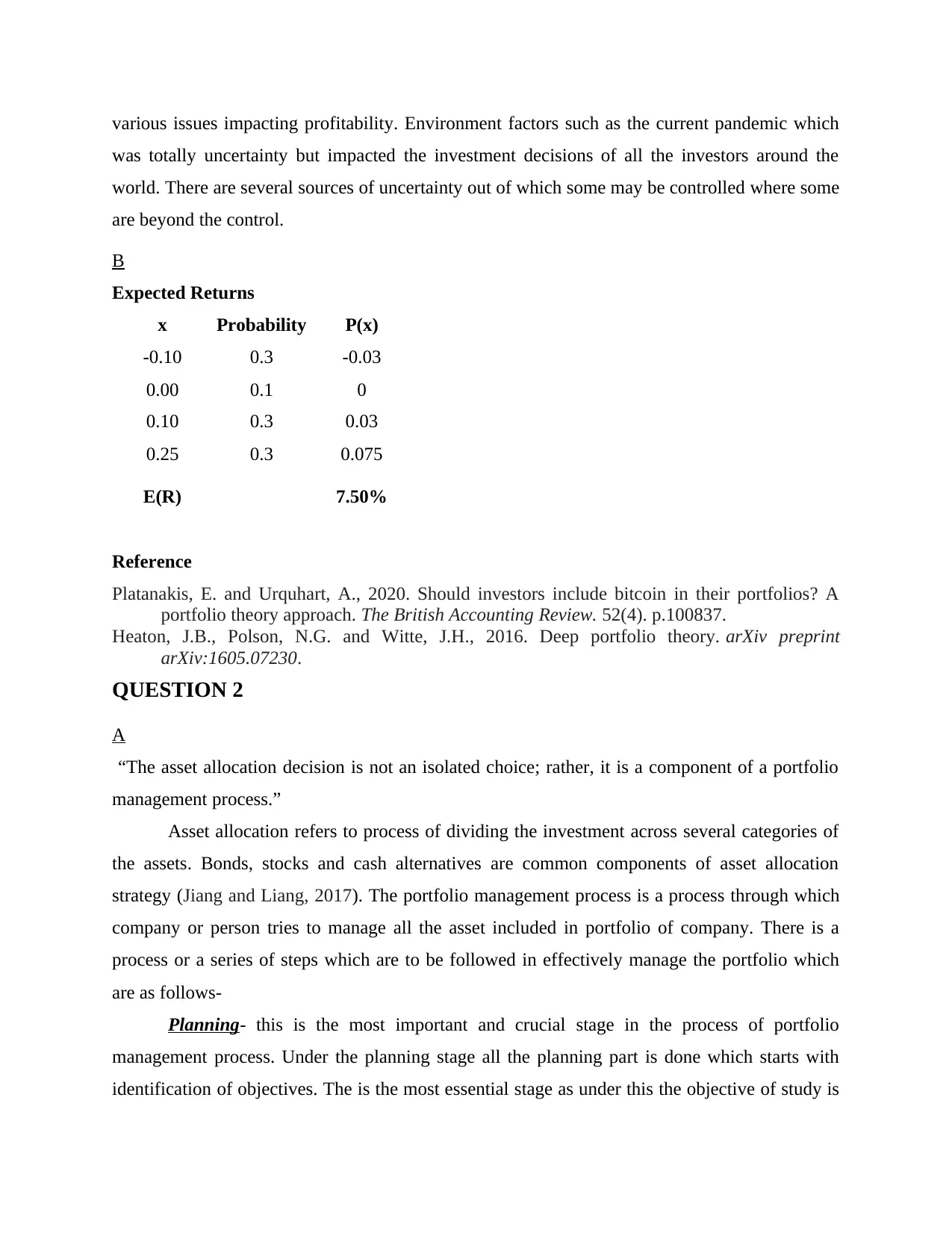
various issues impacting profitability. Environment factors such as the current pandemic which
was totally uncertainty but impacted the investment decisions of all the investors around the
world. There are several sources of uncertainty out of which some may be controlled where some
are beyond the control.
B
Expected Returns
x Probability P(x)
-0.10 0.3 -0.03
0.00 0.1 0
0.10 0.3 0.03
0.25 0.3 0.075
E(R) 7.50%
Reference
Platanakis, E. and Urquhart, A., 2020. Should investors include bitcoin in their portfolios? A
portfolio theory approach. The British Accounting Review. 52(4). p.100837.
Heaton, J.B., Polson, N.G. and Witte, J.H., 2016. Deep portfolio theory. arXiv preprint
arXiv:1605.07230.
QUESTION 2
A
“The asset allocation decision is not an isolated choice; rather, it is a component of a portfolio
management process.”
Asset allocation refers to process of dividing the investment across several categories of
the assets. Bonds, stocks and cash alternatives are common components of asset allocation
strategy (Jiang and Liang, 2017). The portfolio management process is a process through which
company or person tries to manage all the asset included in portfolio of company. There is a
process or a series of steps which are to be followed in effectively manage the portfolio which
are as follows-
Planning- this is the most important and crucial stage in the process of portfolio
management process. Under the planning stage all the planning part is done which starts with
identification of objectives. The is the most essential stage as under this the objective of study is
was totally uncertainty but impacted the investment decisions of all the investors around the
world. There are several sources of uncertainty out of which some may be controlled where some
are beyond the control.
B
Expected Returns
x Probability P(x)
-0.10 0.3 -0.03
0.00 0.1 0
0.10 0.3 0.03
0.25 0.3 0.075
E(R) 7.50%
Reference
Platanakis, E. and Urquhart, A., 2020. Should investors include bitcoin in their portfolios? A
portfolio theory approach. The British Accounting Review. 52(4). p.100837.
Heaton, J.B., Polson, N.G. and Witte, J.H., 2016. Deep portfolio theory. arXiv preprint
arXiv:1605.07230.
QUESTION 2
A
“The asset allocation decision is not an isolated choice; rather, it is a component of a portfolio
management process.”
Asset allocation refers to process of dividing the investment across several categories of
the assets. Bonds, stocks and cash alternatives are common components of asset allocation
strategy (Jiang and Liang, 2017). The portfolio management process is a process through which
company or person tries to manage all the asset included in portfolio of company. There is a
process or a series of steps which are to be followed in effectively manage the portfolio which
are as follows-
Planning- this is the most important and crucial stage in the process of portfolio
management process. Under the planning stage all the planning part is done which starts with
identification of objectives. The is the most essential stage as under this the objective of study is

being identified whether investment need to be done for long- term or short- term purpose
(Portfolio management process, 2020). Further, after knowing the objective, investment policy
statement is being prepared which includes the draft of list of investment matching the
objectives. Further the capital market expectations are also analysed that is the investment option
in which company is planning to invest is likely to grow or not and what are their growth
potential (Im, Nam and Cho, 2020). Further, under planning comes asset allocation strategy
which is very important for managing portfolio. Under this there are two ways that is strategic
asset allocation and tactical asset allocation. Under the strategic allocation investment policy
statement and capital market expectations are merged and analysed. Whereas in tactical all short
term change in the strategy of portfolio with respect to changes in market expectation are
analysed.
Execution- this is the next stage in portfolio management process wherein a portfolio is
created or selected on basis of objectives identified in planning stage. Under portfolio selection
expectation of capital market is combined with investment allocation strategy in order to choose
specific asset for investor's portfolio. The next stage in execution is implementation of portfolio
wherein the portfolio selected finally is implemented.
Feedback- this is the last stage of the portfolio management process under which
continuous monitoring of the portfolio is done. This monitoring is essential as this will assist in
continuous review that whether the working of asset in portfolio is going in same manner or not.
Hence, after the monitoring the performance of investment is evaluated and necessary action are
taken.
B
“The performance of portfolio should be compared to guidelines specified in policy
statement, not on portfolio’s overall return.” this statement is not much correct because of the
reason that policy statement includes the guidelines relating to investment but it is not necessary
that what is specified in policy is currently working in the same manner in capital market. Hence,
because of this reason it is necessary that company assess the value of portfolio on the basis of
overall return of portfolio and not on basis of guidelines specified in policy statement. There are
many different ways or standards against which company can calculate the performance of
portfolio. These are listed as follows-
(Portfolio management process, 2020). Further, after knowing the objective, investment policy
statement is being prepared which includes the draft of list of investment matching the
objectives. Further the capital market expectations are also analysed that is the investment option
in which company is planning to invest is likely to grow or not and what are their growth
potential (Im, Nam and Cho, 2020). Further, under planning comes asset allocation strategy
which is very important for managing portfolio. Under this there are two ways that is strategic
asset allocation and tactical asset allocation. Under the strategic allocation investment policy
statement and capital market expectations are merged and analysed. Whereas in tactical all short
term change in the strategy of portfolio with respect to changes in market expectation are
analysed.
Execution- this is the next stage in portfolio management process wherein a portfolio is
created or selected on basis of objectives identified in planning stage. Under portfolio selection
expectation of capital market is combined with investment allocation strategy in order to choose
specific asset for investor's portfolio. The next stage in execution is implementation of portfolio
wherein the portfolio selected finally is implemented.
Feedback- this is the last stage of the portfolio management process under which
continuous monitoring of the portfolio is done. This monitoring is essential as this will assist in
continuous review that whether the working of asset in portfolio is going in same manner or not.
Hence, after the monitoring the performance of investment is evaluated and necessary action are
taken.
B
“The performance of portfolio should be compared to guidelines specified in policy
statement, not on portfolio’s overall return.” this statement is not much correct because of the
reason that policy statement includes the guidelines relating to investment but it is not necessary
that what is specified in policy is currently working in the same manner in capital market. Hence,
because of this reason it is necessary that company assess the value of portfolio on the basis of
overall return of portfolio and not on basis of guidelines specified in policy statement. There are
many different ways or standards against which company can calculate the performance of
portfolio. These are listed as follows-
Secure Best Marks with AI Grader
Need help grading? Try our AI Grader for instant feedback on your assignments.

Sum of parts- this is a method wherein all the particulars or the asset coming in the
portfolio are calculated on individual basis. This means that company will calculate profit earned
or loss incurred on each of the specific activity in portfolio and then all values are combined and
then overall profit or loss is incurred (Kock and Georg Gemünden, 2016).
The beginning vs. end- this is another standard against which the value of portfolio can
be calculated and performance of portfolio is assessed. Under this the beginning value and the
value of investment in the end of the financial year is compared. This states that if beginning
value of portfolio is less as compared to the end value then it concludes the investment has
performed well. In contrast to this is the beginning value is more as compared to the end value
then it suggests that the investment has not earned much profit and is not good for company.
References
Jiang, Z. and Liang, J., 2017, September. Cryptocurrency portfolio management with deep
reinforcement learning. In 2017 Intelligent Systems Conference (IntelliSys) (pp. 905-
913). IEEE.
Im, K., Nam, K. and Cho, H., 2020. Towards successful business model management with
analytic network process-based feasibility evaluation and portfolio
management. Electronic Markets, pp.1-15.
Kock, A. and Georg Gemünden, H., 2016. Antecedents to decision‐making quality and agility in
innovation portfolio management. Journal of Product Innovation Management, 33(6),
pp.670-686.
Online
Portfolio management process. 2020. [Online]. Available through:
<https://efinancemanagement.com/investment-decisions/portfolio-management-process>
QUESTION 3
It is rightly said that the capital market instrument are fixed income obligations which are
traded in secondary market and can be purchased or sell to other individual. The capital market is
that part of financial system wherein the major focus is concerned with raising of capital with
help of shares, debenture and other long term investment methods (Aggarwal, 2017). These
capital market instrument are the instrument through which one can generate finance for the
company and try to use that money in business to develop it. There are a large number of
instrument which can be used by companies as a capital market instrument for raising of capital
in business. These instruments are discussed as below-
Equities- this is the major source of capital market instrument through which company
can issue capital from selling it in secondary market. Under this method of capital instrument the
portfolio are calculated on individual basis. This means that company will calculate profit earned
or loss incurred on each of the specific activity in portfolio and then all values are combined and
then overall profit or loss is incurred (Kock and Georg Gemünden, 2016).
The beginning vs. end- this is another standard against which the value of portfolio can
be calculated and performance of portfolio is assessed. Under this the beginning value and the
value of investment in the end of the financial year is compared. This states that if beginning
value of portfolio is less as compared to the end value then it concludes the investment has
performed well. In contrast to this is the beginning value is more as compared to the end value
then it suggests that the investment has not earned much profit and is not good for company.
References
Jiang, Z. and Liang, J., 2017, September. Cryptocurrency portfolio management with deep
reinforcement learning. In 2017 Intelligent Systems Conference (IntelliSys) (pp. 905-
913). IEEE.
Im, K., Nam, K. and Cho, H., 2020. Towards successful business model management with
analytic network process-based feasibility evaluation and portfolio
management. Electronic Markets, pp.1-15.
Kock, A. and Georg Gemünden, H., 2016. Antecedents to decision‐making quality and agility in
innovation portfolio management. Journal of Product Innovation Management, 33(6),
pp.670-686.
Online
Portfolio management process. 2020. [Online]. Available through:
<https://efinancemanagement.com/investment-decisions/portfolio-management-process>
QUESTION 3
It is rightly said that the capital market instrument are fixed income obligations which are
traded in secondary market and can be purchased or sell to other individual. The capital market is
that part of financial system wherein the major focus is concerned with raising of capital with
help of shares, debenture and other long term investment methods (Aggarwal, 2017). These
capital market instrument are the instrument through which one can generate finance for the
company and try to use that money in business to develop it. There are a large number of
instrument which can be used by companies as a capital market instrument for raising of capital
in business. These instruments are discussed as below-
Equities- this is the major source of capital market instrument through which company
can issue capital from selling it in secondary market. Under this method of capital instrument the
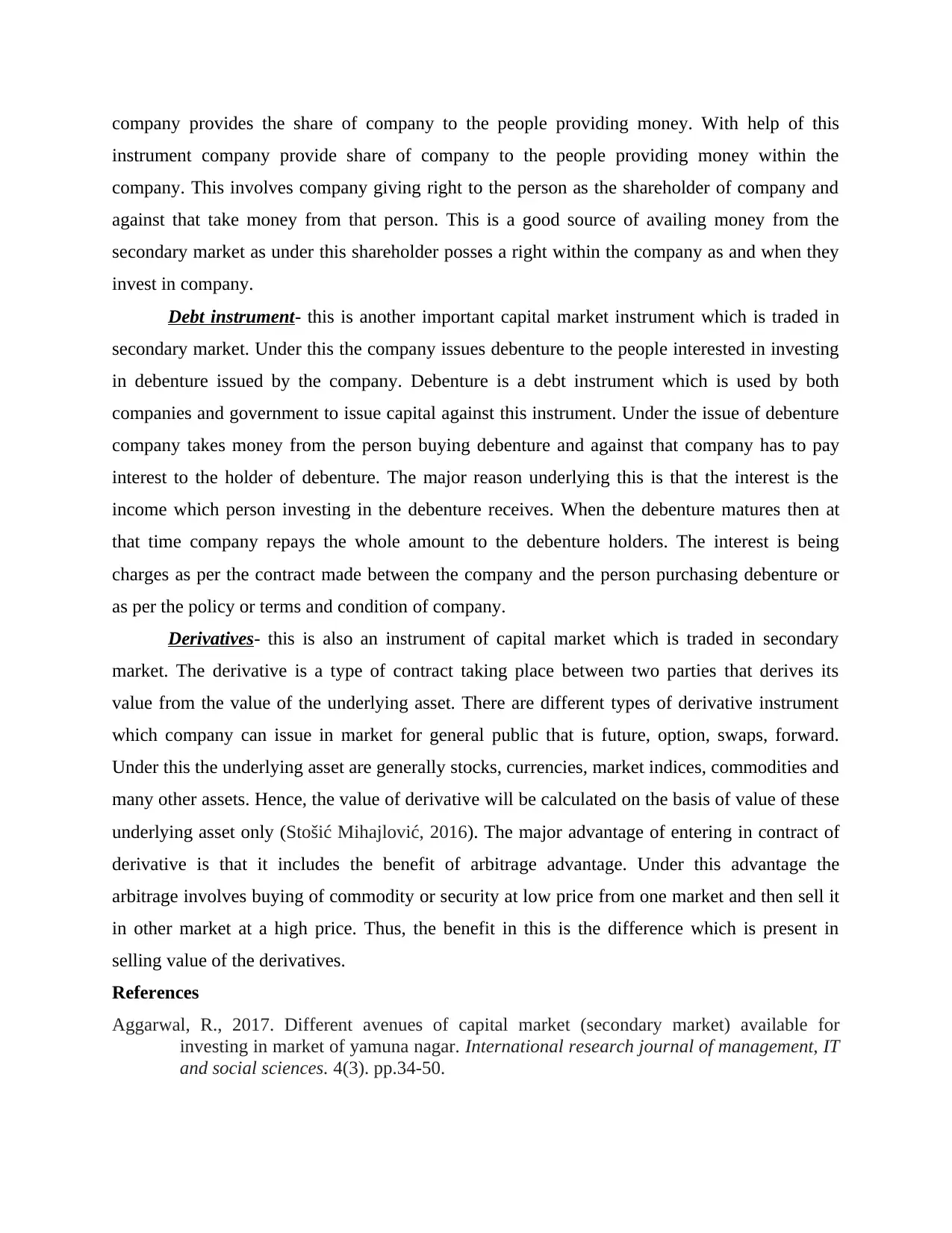
company provides the share of company to the people providing money. With help of this
instrument company provide share of company to the people providing money within the
company. This involves company giving right to the person as the shareholder of company and
against that take money from that person. This is a good source of availing money from the
secondary market as under this shareholder posses a right within the company as and when they
invest in company.
Debt instrument- this is another important capital market instrument which is traded in
secondary market. Under this the company issues debenture to the people interested in investing
in debenture issued by the company. Debenture is a debt instrument which is used by both
companies and government to issue capital against this instrument. Under the issue of debenture
company takes money from the person buying debenture and against that company has to pay
interest to the holder of debenture. The major reason underlying this is that the interest is the
income which person investing in the debenture receives. When the debenture matures then at
that time company repays the whole amount to the debenture holders. The interest is being
charges as per the contract made between the company and the person purchasing debenture or
as per the policy or terms and condition of company.
Derivatives- this is also an instrument of capital market which is traded in secondary
market. The derivative is a type of contract taking place between two parties that derives its
value from the value of the underlying asset. There are different types of derivative instrument
which company can issue in market for general public that is future, option, swaps, forward.
Under this the underlying asset are generally stocks, currencies, market indices, commodities and
many other assets. Hence, the value of derivative will be calculated on the basis of value of these
underlying asset only (Stošić Mihajlović, 2016). The major advantage of entering in contract of
derivative is that it includes the benefit of arbitrage advantage. Under this advantage the
arbitrage involves buying of commodity or security at low price from one market and then sell it
in other market at a high price. Thus, the benefit in this is the difference which is present in
selling value of the derivatives.
References
Aggarwal, R., 2017. Different avenues of capital market (secondary market) available for
investing in market of yamuna nagar. International research journal of management, IT
and social sciences. 4(3). pp.34-50.
instrument company provide share of company to the people providing money within the
company. This involves company giving right to the person as the shareholder of company and
against that take money from that person. This is a good source of availing money from the
secondary market as under this shareholder posses a right within the company as and when they
invest in company.
Debt instrument- this is another important capital market instrument which is traded in
secondary market. Under this the company issues debenture to the people interested in investing
in debenture issued by the company. Debenture is a debt instrument which is used by both
companies and government to issue capital against this instrument. Under the issue of debenture
company takes money from the person buying debenture and against that company has to pay
interest to the holder of debenture. The major reason underlying this is that the interest is the
income which person investing in the debenture receives. When the debenture matures then at
that time company repays the whole amount to the debenture holders. The interest is being
charges as per the contract made between the company and the person purchasing debenture or
as per the policy or terms and condition of company.
Derivatives- this is also an instrument of capital market which is traded in secondary
market. The derivative is a type of contract taking place between two parties that derives its
value from the value of the underlying asset. There are different types of derivative instrument
which company can issue in market for general public that is future, option, swaps, forward.
Under this the underlying asset are generally stocks, currencies, market indices, commodities and
many other assets. Hence, the value of derivative will be calculated on the basis of value of these
underlying asset only (Stošić Mihajlović, 2016). The major advantage of entering in contract of
derivative is that it includes the benefit of arbitrage advantage. Under this advantage the
arbitrage involves buying of commodity or security at low price from one market and then sell it
in other market at a high price. Thus, the benefit in this is the difference which is present in
selling value of the derivatives.
References
Aggarwal, R., 2017. Different avenues of capital market (secondary market) available for
investing in market of yamuna nagar. International research journal of management, IT
and social sciences. 4(3). pp.34-50.
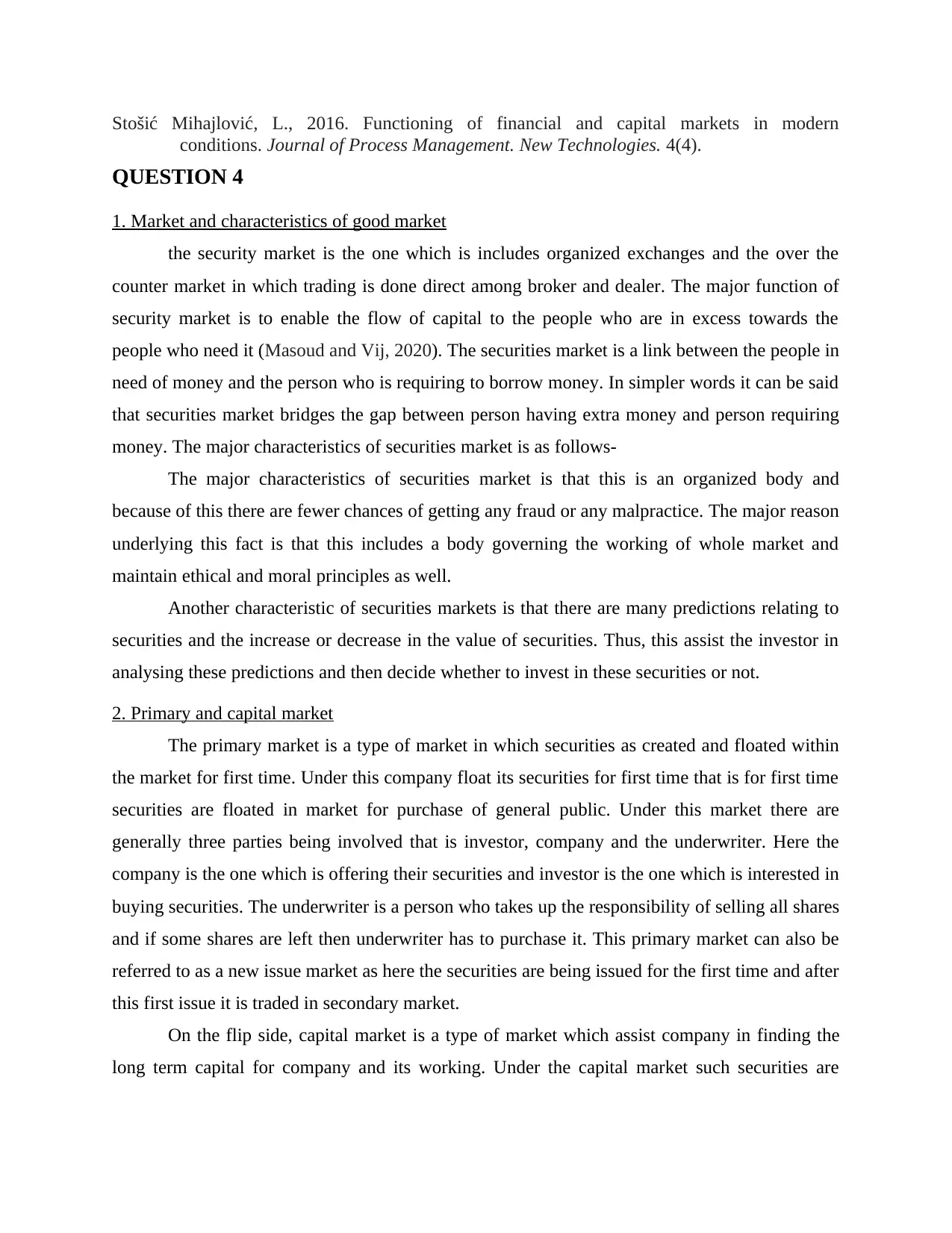
Stošić Mihajlović, L., 2016. Functioning of financial and capital markets in modern
conditions. Journal of Process Management. New Technologies. 4(4).
QUESTION 4
1. Market and characteristics of good market
the security market is the one which is includes organized exchanges and the over the
counter market in which trading is done direct among broker and dealer. The major function of
security market is to enable the flow of capital to the people who are in excess towards the
people who need it (Masoud and Vij, 2020). The securities market is a link between the people in
need of money and the person who is requiring to borrow money. In simpler words it can be said
that securities market bridges the gap between person having extra money and person requiring
money. The major characteristics of securities market is as follows-
The major characteristics of securities market is that this is an organized body and
because of this there are fewer chances of getting any fraud or any malpractice. The major reason
underlying this fact is that this includes a body governing the working of whole market and
maintain ethical and moral principles as well.
Another characteristic of securities markets is that there are many predictions relating to
securities and the increase or decrease in the value of securities. Thus, this assist the investor in
analysing these predictions and then decide whether to invest in these securities or not.
2. Primary and capital market
The primary market is a type of market in which securities as created and floated within
the market for first time. Under this company float its securities for first time that is for first time
securities are floated in market for purchase of general public. Under this market there are
generally three parties being involved that is investor, company and the underwriter. Here the
company is the one which is offering their securities and investor is the one which is interested in
buying securities. The underwriter is a person who takes up the responsibility of selling all shares
and if some shares are left then underwriter has to purchase it. This primary market can also be
referred to as a new issue market as here the securities are being issued for the first time and after
this first issue it is traded in secondary market.
On the flip side, capital market is a type of market which assist company in finding the
long term capital for company and its working. Under the capital market such securities are
conditions. Journal of Process Management. New Technologies. 4(4).
QUESTION 4
1. Market and characteristics of good market
the security market is the one which is includes organized exchanges and the over the
counter market in which trading is done direct among broker and dealer. The major function of
security market is to enable the flow of capital to the people who are in excess towards the
people who need it (Masoud and Vij, 2020). The securities market is a link between the people in
need of money and the person who is requiring to borrow money. In simpler words it can be said
that securities market bridges the gap between person having extra money and person requiring
money. The major characteristics of securities market is as follows-
The major characteristics of securities market is that this is an organized body and
because of this there are fewer chances of getting any fraud or any malpractice. The major reason
underlying this fact is that this includes a body governing the working of whole market and
maintain ethical and moral principles as well.
Another characteristic of securities markets is that there are many predictions relating to
securities and the increase or decrease in the value of securities. Thus, this assist the investor in
analysing these predictions and then decide whether to invest in these securities or not.
2. Primary and capital market
The primary market is a type of market in which securities as created and floated within
the market for first time. Under this company float its securities for first time that is for first time
securities are floated in market for purchase of general public. Under this market there are
generally three parties being involved that is investor, company and the underwriter. Here the
company is the one which is offering their securities and investor is the one which is interested in
buying securities. The underwriter is a person who takes up the responsibility of selling all shares
and if some shares are left then underwriter has to purchase it. This primary market can also be
referred to as a new issue market as here the securities are being issued for the first time and after
this first issue it is traded in secondary market.
On the flip side, capital market is a type of market which assist company in finding the
long term capital for company and its working. Under the capital market such securities are
Paraphrase This Document
Need a fresh take? Get an instant paraphrase of this document with our AI Paraphraser

being traded which assist company in borrowing or generating long term debt for better working
of company (Szczygielski, Mikutowski and Zaremba, 2019).
3. Secondary financial market
The secondary financial market is a market place wherein the investor can buy and sell
securities which they posses. This can be commonly called as stock market wherein all the
companies are being listed and general public can trade in it. For this the companies have to list
their shares over the regional or national and internation stock exchanges. After the listing of
securities and shares company becomes a listed company and any person can deal in the
securities.
References
Masoud, N. and Vij, A., 2020. The effect of mandatory CSR disclosure on firms: empirical
evidence from UAE. International Journal of Sustainable Engineering, pp.1-12.
Szczygielski, J.J., Mikutowski, M. and Zaremba, A., 2019. Is there a low-risk anomaly in the
UAE stock market?. Journal of Research in Emerging Markets. 1(2). pp.39-44.
QUESTION 6
1. Industry analysis
For any business to run in a successful manner the most important thing is to analyse the
fact that how the industry is working. The major reason behind this fact is that if any company
want to access its financial position than for that first they have to perform an analysis of
industry and its position (Aithal, 2017). Even if a new company wants to enter into an industry
then for that first thing is to analyse and inspect the working of the industry as a whole. This will
include the analysis of whole industry that is what are trends going on industry, what is the
competition, what are the consumer types, target market and other related things. This analysis of
industry will be helpful for the company entering the market as this will be a guide to the
company that how company is working. So because of this reason industry analysis always
comes before analysing any similar company or competitors.
2. Business cycle and industry sector
For the business analysis of any company it is very essential to analyse its business cycle
and industry sector. The business exist in an economy which is governed by the working of the
economy and the market forces of economy. Hence, for this it is also very essential for the
company to analyse its business cycle of the industry sector in which it is operating. The
of company (Szczygielski, Mikutowski and Zaremba, 2019).
3. Secondary financial market
The secondary financial market is a market place wherein the investor can buy and sell
securities which they posses. This can be commonly called as stock market wherein all the
companies are being listed and general public can trade in it. For this the companies have to list
their shares over the regional or national and internation stock exchanges. After the listing of
securities and shares company becomes a listed company and any person can deal in the
securities.
References
Masoud, N. and Vij, A., 2020. The effect of mandatory CSR disclosure on firms: empirical
evidence from UAE. International Journal of Sustainable Engineering, pp.1-12.
Szczygielski, J.J., Mikutowski, M. and Zaremba, A., 2019. Is there a low-risk anomaly in the
UAE stock market?. Journal of Research in Emerging Markets. 1(2). pp.39-44.
QUESTION 6
1. Industry analysis
For any business to run in a successful manner the most important thing is to analyse the
fact that how the industry is working. The major reason behind this fact is that if any company
want to access its financial position than for that first they have to perform an analysis of
industry and its position (Aithal, 2017). Even if a new company wants to enter into an industry
then for that first thing is to analyse and inspect the working of the industry as a whole. This will
include the analysis of whole industry that is what are trends going on industry, what is the
competition, what are the consumer types, target market and other related things. This analysis of
industry will be helpful for the company entering the market as this will be a guide to the
company that how company is working. So because of this reason industry analysis always
comes before analysing any similar company or competitors.
2. Business cycle and industry sector
For the business analysis of any company it is very essential to analyse its business cycle
and industry sector. The business exist in an economy which is governed by the working of the
economy and the market forces of economy. Hence, for this it is also very essential for the
company to analyse its business cycle of the industry sector in which it is operating. The
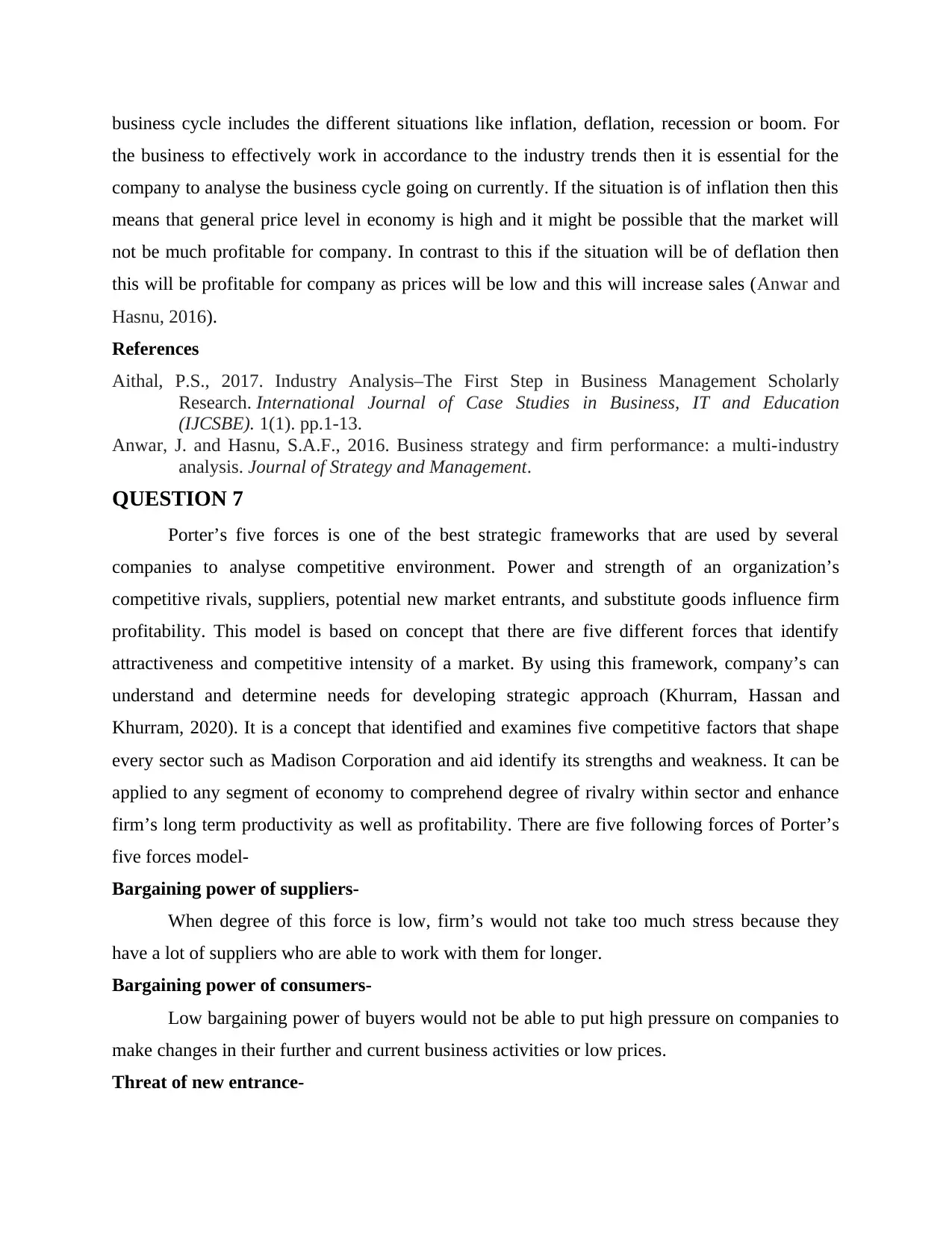
business cycle includes the different situations like inflation, deflation, recession or boom. For
the business to effectively work in accordance to the industry trends then it is essential for the
company to analyse the business cycle going on currently. If the situation is of inflation then this
means that general price level in economy is high and it might be possible that the market will
not be much profitable for company. In contrast to this if the situation will be of deflation then
this will be profitable for company as prices will be low and this will increase sales (Anwar and
Hasnu, 2016).
References
Aithal, P.S., 2017. Industry Analysis–The First Step in Business Management Scholarly
Research. International Journal of Case Studies in Business, IT and Education
(IJCSBE). 1(1). pp.1-13.
Anwar, J. and Hasnu, S.A.F., 2016. Business strategy and firm performance: a multi-industry
analysis. Journal of Strategy and Management.
QUESTION 7
Porter’s five forces is one of the best strategic frameworks that are used by several
companies to analyse competitive environment. Power and strength of an organization’s
competitive rivals, suppliers, potential new market entrants, and substitute goods influence firm
profitability. This model is based on concept that there are five different forces that identify
attractiveness and competitive intensity of a market. By using this framework, company’s can
understand and determine needs for developing strategic approach (Khurram, Hassan and
Khurram, 2020). It is a concept that identified and examines five competitive factors that shape
every sector such as Madison Corporation and aid identify its strengths and weakness. It can be
applied to any segment of economy to comprehend degree of rivalry within sector and enhance
firm’s long term productivity as well as profitability. There are five following forces of Porter’s
five forces model-
Bargaining power of suppliers-
When degree of this force is low, firm’s would not take too much stress because they
have a lot of suppliers who are able to work with them for longer.
Bargaining power of consumers-
Low bargaining power of buyers would not be able to put high pressure on companies to
make changes in their further and current business activities or low prices.
Threat of new entrance-
the business to effectively work in accordance to the industry trends then it is essential for the
company to analyse the business cycle going on currently. If the situation is of inflation then this
means that general price level in economy is high and it might be possible that the market will
not be much profitable for company. In contrast to this if the situation will be of deflation then
this will be profitable for company as prices will be low and this will increase sales (Anwar and
Hasnu, 2016).
References
Aithal, P.S., 2017. Industry Analysis–The First Step in Business Management Scholarly
Research. International Journal of Case Studies in Business, IT and Education
(IJCSBE). 1(1). pp.1-13.
Anwar, J. and Hasnu, S.A.F., 2016. Business strategy and firm performance: a multi-industry
analysis. Journal of Strategy and Management.
QUESTION 7
Porter’s five forces is one of the best strategic frameworks that are used by several
companies to analyse competitive environment. Power and strength of an organization’s
competitive rivals, suppliers, potential new market entrants, and substitute goods influence firm
profitability. This model is based on concept that there are five different forces that identify
attractiveness and competitive intensity of a market. By using this framework, company’s can
understand and determine needs for developing strategic approach (Khurram, Hassan and
Khurram, 2020). It is a concept that identified and examines five competitive factors that shape
every sector such as Madison Corporation and aid identify its strengths and weakness. It can be
applied to any segment of economy to comprehend degree of rivalry within sector and enhance
firm’s long term productivity as well as profitability. There are five following forces of Porter’s
five forces model-
Bargaining power of suppliers-
When degree of this force is low, firm’s would not take too much stress because they
have a lot of suppliers who are able to work with them for longer.
Bargaining power of consumers-
Low bargaining power of buyers would not be able to put high pressure on companies to
make changes in their further and current business activities or low prices.
Threat of new entrance-
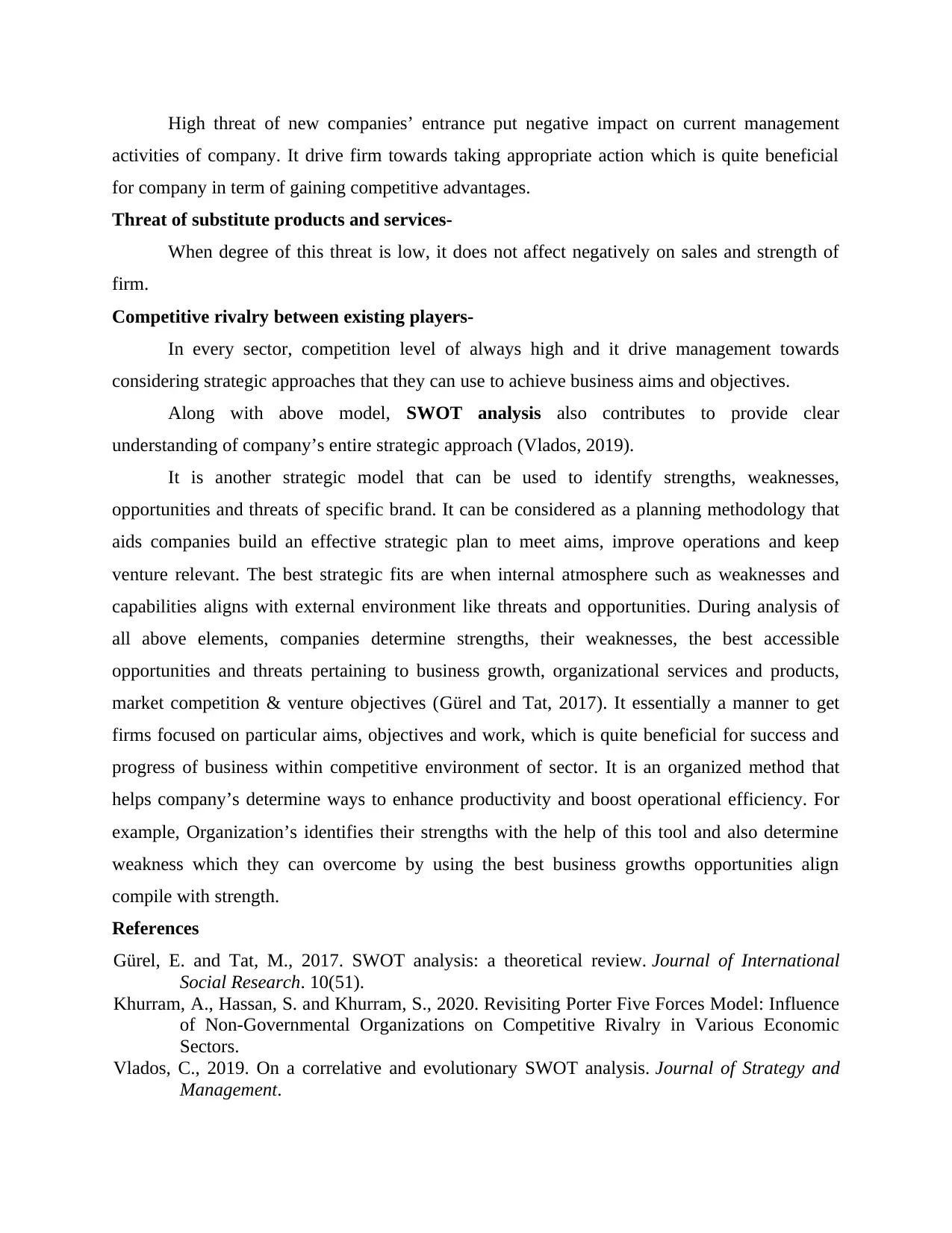
High threat of new companies’ entrance put negative impact on current management
activities of company. It drive firm towards taking appropriate action which is quite beneficial
for company in term of gaining competitive advantages.
Threat of substitute products and services-
When degree of this threat is low, it does not affect negatively on sales and strength of
firm.
Competitive rivalry between existing players-
In every sector, competition level of always high and it drive management towards
considering strategic approaches that they can use to achieve business aims and objectives.
Along with above model, SWOT analysis also contributes to provide clear
understanding of company’s entire strategic approach (Vlados, 2019).
It is another strategic model that can be used to identify strengths, weaknesses,
opportunities and threats of specific brand. It can be considered as a planning methodology that
aids companies build an effective strategic plan to meet aims, improve operations and keep
venture relevant. The best strategic fits are when internal atmosphere such as weaknesses and
capabilities aligns with external environment like threats and opportunities. During analysis of
all above elements, companies determine strengths, their weaknesses, the best accessible
opportunities and threats pertaining to business growth, organizational services and products,
market competition & venture objectives (Gürel and Tat, 2017). It essentially a manner to get
firms focused on particular aims, objectives and work, which is quite beneficial for success and
progress of business within competitive environment of sector. It is an organized method that
helps company’s determine ways to enhance productivity and boost operational efficiency. For
example, Organization’s identifies their strengths with the help of this tool and also determine
weakness which they can overcome by using the best business growths opportunities align
compile with strength.
References
Gürel, E. and Tat, M., 2017. SWOT analysis: a theoretical review. Journal of International
Social Research. 10(51).
Khurram, A., Hassan, S. and Khurram, S., 2020. Revisiting Porter Five Forces Model: Influence
of Non-Governmental Organizations on Competitive Rivalry in Various Economic
Sectors.
Vlados, C., 2019. On a correlative and evolutionary SWOT analysis. Journal of Strategy and
Management.
activities of company. It drive firm towards taking appropriate action which is quite beneficial
for company in term of gaining competitive advantages.
Threat of substitute products and services-
When degree of this threat is low, it does not affect negatively on sales and strength of
firm.
Competitive rivalry between existing players-
In every sector, competition level of always high and it drive management towards
considering strategic approaches that they can use to achieve business aims and objectives.
Along with above model, SWOT analysis also contributes to provide clear
understanding of company’s entire strategic approach (Vlados, 2019).
It is another strategic model that can be used to identify strengths, weaknesses,
opportunities and threats of specific brand. It can be considered as a planning methodology that
aids companies build an effective strategic plan to meet aims, improve operations and keep
venture relevant. The best strategic fits are when internal atmosphere such as weaknesses and
capabilities aligns with external environment like threats and opportunities. During analysis of
all above elements, companies determine strengths, their weaknesses, the best accessible
opportunities and threats pertaining to business growth, organizational services and products,
market competition & venture objectives (Gürel and Tat, 2017). It essentially a manner to get
firms focused on particular aims, objectives and work, which is quite beneficial for success and
progress of business within competitive environment of sector. It is an organized method that
helps company’s determine ways to enhance productivity and boost operational efficiency. For
example, Organization’s identifies their strengths with the help of this tool and also determine
weakness which they can overcome by using the best business growths opportunities align
compile with strength.
References
Gürel, E. and Tat, M., 2017. SWOT analysis: a theoretical review. Journal of International
Social Research. 10(51).
Khurram, A., Hassan, S. and Khurram, S., 2020. Revisiting Porter Five Forces Model: Influence
of Non-Governmental Organizations on Competitive Rivalry in Various Economic
Sectors.
Vlados, C., 2019. On a correlative and evolutionary SWOT analysis. Journal of Strategy and
Management.
Secure Best Marks with AI Grader
Need help grading? Try our AI Grader for instant feedback on your assignments.

1 out of 11
Related Documents
Your All-in-One AI-Powered Toolkit for Academic Success.
+13062052269
info@desklib.com
Available 24*7 on WhatsApp / Email
![[object Object]](/_next/static/media/star-bottom.7253800d.svg)
Unlock your academic potential
© 2024 | Zucol Services PVT LTD | All rights reserved.
